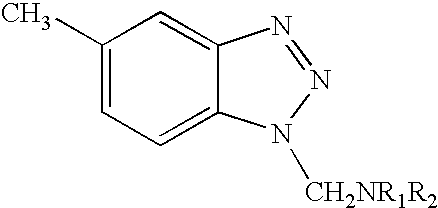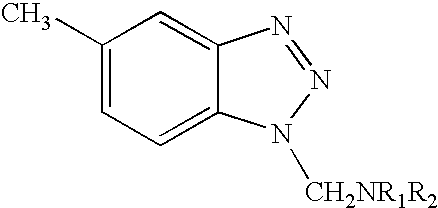Bicine/tricine containing composition and method for chemical-mechanical planarization
a composition and composition technology, applied in lapping machines, other chemical processes, manufacturing tools, etc., can solve the problems of unsuitable semiconductor manufacturing, feature distortion is unacceptable, and the topography difference between the field of dielectrics is not acceptabl
- Summary
- Abstract
- Description
- Claims
- Application Information
AI Technical Summary
Benefits of technology
Problems solved by technology
Method used
Image
Examples
examples
General
[0100] All percentages are weight percentages and all temperatures are degrees Centigrade unless otherwise indicated.
Chemical Mechanical Planarization (CMP) Methodology
[0101] In the examples presented below, chemical mechanical planarization (CMP) experiments were run using the procedures and experimental conditions given below.
[0102] PETEOS thickness was measured with a Nanometrics, model, # 9200, manufactured by Nanometrics Inc, 1550 Buckeye, Milpitas, Calif. 95035-7418. The metal films were measured with a ResiMap CDE, model 168, manufactured by Creative Design Engineering, Inc, 20565 Alves Dr, Cupertino, Calif., 95014. This tool is a four-point probe sheet resistance tool. Twenty-five and forty nine-point polar scans were taken with the respective tools at 3-mm edge exclusion. Planarity measurements were conducted on a P-15 Surface Profiler manufactured by KLA® Tencore, 160 Rio Robles, San Jose, Calif. 95161-9055.
CMP Tool
[0103] The CMP tool that was us...
examples 1 and 3
in Table 1
[0112] In Table 1, Example 1 and Example 3 are inventive examples using bicine and tricine, respectively, whereas Example 2 is a comparative example using citric acid. In Example 1, in addition to bicine, the formulation also contains DP106 as an abrasive, H2O2, triazole, deionized water, polyamidopolyethyleneimine, and CDX2165 as shown in Table 1. In Example 3, in addition to tricine, the formulation also contains DP106 as an abrasive, H2O2, triazole, deionized water, polyamidopolyethyleneimine (BASF Corporation, 36 Riverside Ave., Rensselaer, N.Y., 12144), and CDX2165 as shown in Table 1.
[0113] The polishing formulations were used to polish copper, tantalum, and PETEOS blanket wafers at 4.5 psi and 2 psi. The removal rate and selectivity data are tabulated in Table 1 under Example 1 and Example 3. The tricine-containing formulation gave copper to tantalum selectivity of 65 and copper to PETEOS selectivity of 36 whereas the bicine-containing formulation gave copper to ta...
examples 4 , 5
Examples 4, 5, and 6 in Table 2
[0115] These examples demonstrate the comparison between a tricine-based composition and a bicine-based composition versus a citric acid-based polishing composition in the presence of triazole on the level of dishing measured on patterned wafers. The compositions used are shown in Table 2. As shown in Table 2, the average dishing level of the tricine-based composition (Example 5) was 386 Å versus an average dishing level of 625 Å for the citric acid-based composition (Comparative Example 4). Interestingly, the bicine and tricine based formulations were essentially equivalent in dishing performance. More specifically, dishing at 100 micron line for the tricine-based formulation (Example 5) was 386 Å versus 345 Å for the bicine-based formulation (Example 6).
TABLE 2Comparison of Bicine-, Tricine- and Citric acid-BasedCMP Slurries with Respect to DishingExample 4(Comparative)Example 5Example 6Formulation0.8% Citric acid0.8% Tricine0.8% Bicine2.5% DP1062....
PUM
| Property | Measurement | Unit |
|---|---|---|
| weight percent | aaaaa | aaaaa |
| pH | aaaaa | aaaaa |
| dielectric constants | aaaaa | aaaaa |
Abstract
Description
Claims
Application Information
 Login to View More
Login to View More - R&D
- Intellectual Property
- Life Sciences
- Materials
- Tech Scout
- Unparalleled Data Quality
- Higher Quality Content
- 60% Fewer Hallucinations
Browse by: Latest US Patents, China's latest patents, Technical Efficacy Thesaurus, Application Domain, Technology Topic, Popular Technical Reports.
© 2025 PatSnap. All rights reserved.Legal|Privacy policy|Modern Slavery Act Transparency Statement|Sitemap|About US| Contact US: help@patsnap.com



